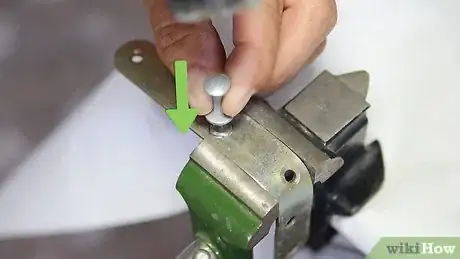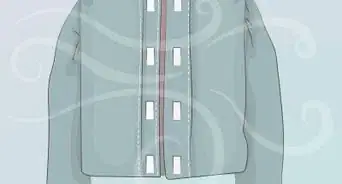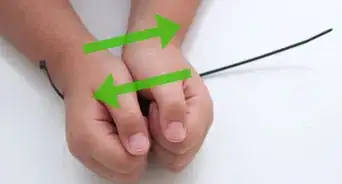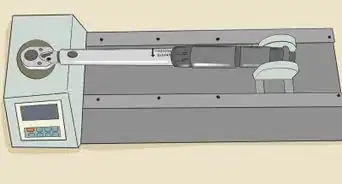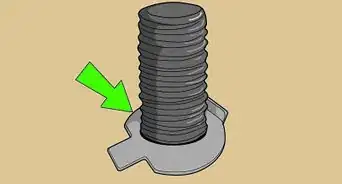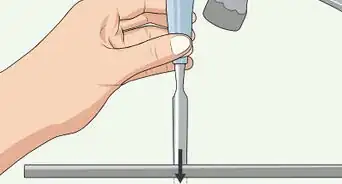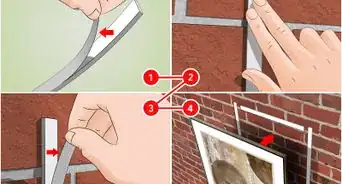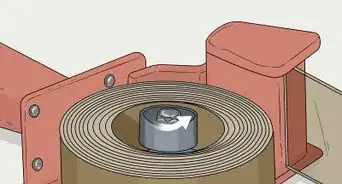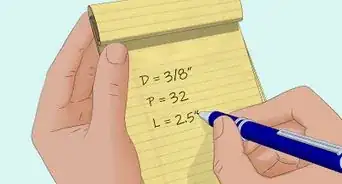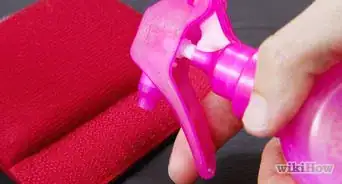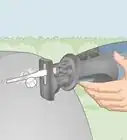This article was co-authored by Duston Maynes. Duston Maynes is an Automotive Repair Specialist at RepairSmith. Duston specializes in leading a team that handles a variety of automotive repairs including replacing spark plugs, front and rear brake pads, fuel pumps, car batteries, alternators, timing belts, and starter motors. Duston holds an Associate’s degree in Automotive/Diesel Technology from The Universal Technical Institute of Arizona and is a Certified Diagnostic Technician and Automobile Mechanics Technician through BMW STEP. RepairSmith received The 2020 Big Innovation Award by Business Intelligence Group and The Startup of the Year by the American Business Awards. RepairSmith was also included in Built in LA’s 50 Startups to Watch and The Business Intelligence Group’s 52 Names Leading the Way in Customer Service. RepairSmith offers in-home services to provide car owners convenient and complete auto repair everywhere.
This article has been viewed 554,090 times.
A bolt is a piece of hardware typically used to hold two or more pieces of lumber in place. Unfortunately, during construction, it is possible for a bolt to break. While this is unusual, inexperienced or rushed work increases the likelihood of it happening. Learning how to remove a broken bolt is essential for the completion of construction or home improvement projects.
Steps
Using an Extracting Kit
-
1Center punch the broken bolt as close to the center as possible. Using a hammer, mark the center of the broken bolt with a center punch. This will help you drill into the center of the bolt as closely as possible, putting you at less risk of damaging the threads of the broken bolt.[1]
-
2Drill a pilot hole into the center of the broken bolt with the left-handed drill bit.[2] A left-handed drill bit is threaded in the opposite direction, so the reverse setting on your drill is what will actually drive in the bit. You want to use a left-handed bit because it will torque in the opposite direction as the broken bolt, which will stop the bolt from being driven in tighter.[3]
- If you’re lucky, the left-handed bit will grab and unscrew the bolt enough by itself for you to grab the bolt with a pair of vice grips or channel locks and finish removing it from there.
- Make sure you use the appropriate size drill bit. The bits in the extracting kit should have a table letting you know what size to use based on the size of the bolt you need to remove. Using too big a bit will risk damaging the threads on the bolt, and using too small a bit will require a smaller, weaker extractor with a higher risk of breaking off during the process.
Advertisement -
3Place the appropriate-size extracting bit into the hole you created with the drill. Based on the type of extracting kit you purchased, the extracting bit will have a tapered, left-handed bit at one end and either a hex head or a T-handle head at the other. Since the extractor is also a left-handed bit, it will also work into the broken bolt with a counterclockwise movement.[4]
- Since the extractor is tapered, you should initially tap it into place with your hammer before switching to a socket or T-handle.
-
4Remove the broken bolt. As you continue to tighten in the extractor, the tapered end will catch and the torque will work to loosen the bolt once the extracting bit is snug.
- Continue turning the extracting tool counterclockwise until the broken bolt has been completely removed from the surface in which it was embedded.
- Be sure to take your time during this process to prevent excessive damage to either the bolt or the item from which you are removing it. You also want to work the extractor as gently as possible because they are made of hardened steel, and a broken off extractor will be even more difficult to drill out.
-
5Remove metal filings. During the bolt-removal process, it is likely that small amounts of metal fillings will have come off of the bolt. If you plan to replace the broken bolt with a new one, it is important to first remove all of these fillings and shaving. You can most easily accomplish this with either a magnet or compressed air.[5]
Using a Welding Technique
-
1Center punch the broken bolt as close to the center as possible. Just like you would using the extractor, you want to use a hammer and a center punch to mark the center of the bolt.
-
2Drill out the center of the bolt. Use a bit that is roughly one-quarter the diameter of the bolt and drill it out.[6]
- This method of extraction is typically reserved for bolts that are too corroded to be removed with an extractor, so you do not need to worry as much about tightening the bolt while drilling it out with a right-handed bit, but using a left-handed bit can’t hurt.
-
3Thread a hex nut onto the bolt. With any threading the bolt still has exposed, tighten a hex nut onto it. You want to attach the nut firmly, but back it off around half a turn, so that it’s not completely flush with the surface into which the bolt is embedded.[7]
-
4Weld the bolt to the nut. This is a quick weld, but you do not want this to be your first attempt at welding. If you need to, have an experienced friend complete the weld, or you can always practice on something else first with the information found at Weld.
- Be especially careful if the surface into which the broken bolt is embedded is one that will melt to the steel bolt or nut. Because of this, this method works best against a surface such as aluminum, which does not easily weld to steel.
-
5Remove the bolt. After the weld has had time to cool, the hex nut has essentially been welded into place as the new head of the bolt and can probably be removed with a socket or a wrench.
- The weld is strong, but it will not be unbreakable. For especially corroded bolts, the nut may have to be welded back in place more than once.
- In order to break the corrosion bonds, try slowly working the bolt back and forth initially. Once it starts to loosen, continue working both directions but more so counterclockwise, so you can begin removing it entirely.[8]
Community Q&A
-
QuestionThe hot water tap in my kitchen only trickles. What is wrong with it?
 Community AnswerIf the cold water runs freely, you may have a blockage in the valve under the sink. Try closing it and opening it again.
Community AnswerIf the cold water runs freely, you may have a blockage in the valve under the sink. Try closing it and opening it again.
Warnings
- Go slow when using an extractor and don’t overpower it. Breaking an extractor off in a broken bolt requires an even stronger material than the hardened steel of the extractor to remove.⧼thumbs_response⧽
- Take every necessary precaution if attempting the welding method, including a welding jacket, welding helmet, gloves, pants without cuffs, and boots.⧼thumbs_response⧽
- Wear eye protection when drilling out the broken bolt since the process will create metal shavings.⧼thumbs_response⧽
Things You'll Need
- Power drill
- Left-handed drill bit
- Extracting bit
- T-handle
- Vise grip
- Magnet
- Hammer
- Center Punch
- Compressed air
- Hex nut
- Welder
- Welding helmet
- Welding jacket
- Gloves
- Safety glasses
References
- ↑ https://www.bobvila.com/articles/how-to-remove-a-broken-bolt/
- ↑ https://www.bobvila.com/articles/how-to-remove-a-broken-bolt/
- ↑ https://www.youtube.com/watch?v=dbZZFWaIzyU
- ↑ https://www.bobvila.com/articles/how-to-remove-a-broken-bolt/
- ↑ https://www.bobvila.com/articles/how-to-remove-a-broken-bolt/
- ↑ https://www.youtube.com/watch?v=bSOg7aQ44eg
- ↑ https://www.youtube.com/watch?v=bSOg7aQ44eg
- ↑ https://www.youtube.com/watch?v=bSOg7aQ44eg
- Videos provided by Ultimate Handyman
About This Article
If you want to remove a broken bolt without welding, center punch the broken bolt, then drill a pilot hole into the center of it with a left-handed drill bit. Next, put an extracting bit into the hole you just drilled and rotate it counter-clockwise until it tightens and unscrews the bolt. Finally, remove any metal filings with a magnet or compressed air before putting a new bolt in the hole. Keep reading to learn how to remove a broken bolt by welding a nut onto it!
